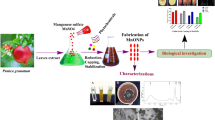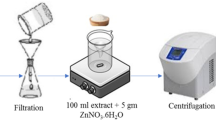Abstract
The need for some economic strategies for increased growth and nutraceuticals of medicinal plants is well acknowledged now. It was hypothesized that external magnetic field treatment (MFT) of seeds affecting internal magnet of cells may affect growth and metabolism. In this study, seeds were subjected to pre-sowing magnetic field (50 mT at 5 mm for 5 s). At vegetative stage, the leaf growth, chlorophyll content, catalase (CAT), peroxidase (POD), amino acids, proteins, flavonoids, soluble sugars, total soluble phenolics, carotenoids, anthocyanins, phenolic profile (HPLC based), and antimicrobial activity of leaves (in terms of the minimum inhibitory concentration against Staphylococcus aureus and Pseudomonas aeruginosa) were studied. Yield was evaluated for nutritive components in fruit (peel+pulp) and peel. MFT improved germination percentage, growth, leaf chlorophyll, antimicrobial activity, peel amino acids, phenolics, and POD with negligible effect on fruit nutritive value. Moreover, photosynthetic pigments and cinnamic acid exhibited direct correlation with antimicrobial potential against both pathogens. However, sinapic acid showed positive correlation against Staphylococcus aureus only. Cinnamic acid, coumaric acid, syringic acid, and quercetin were in direct correlation against Pseudomonas aeruginosa; it was directly correlated with total flavonoids too. In conclusion, magnetic field can be used to manipulate plant cell metabolism promising improvement of growth, antimicrobial activity, and phenolics of interest.






Similar content being viewed by others
References
Justo, O. R., Pérez, V. H., Alvarez, D. C., & Alegre, R. M. (2006). Growth of Escherichia coli under extremely low-frequency electromagnetic fields. Applied Biochemistry and Biotechnology, 134(2), 155–163. https://doi.org/10.1385/ABAB:134:2:155.
Perveen, R., Ali, Q., Ashraf, M., Jamil, Y., & Ahmad, R. M. (2010). Effect of different doses of low power continuous wave He-Ne laser radiation on some seed thermodynamic and germination parameters and potential enzymes involved in seed germination of sunflower (Helianthus annus L). Photochemistry and Photobiology, 86(5), 1050–1055. https://doi.org/10.1111/j.1751-1097.2010.00782.x.
Kordas, L. (2002). The effect of magnetic field on growth, development and the yield of spring wheat. Polish Journal of Environmental Studies, 11(5), 527–530.
Tapas, A. R., Sakarkar, D. M., & Kakde, R. B. (2008). Flavonoids as nutraceuticals: a review. Tropical Journal of Pharmaceutical Research, 7(3), 1089–1099. https://doi.org/10.4314/tjpr.v7i3.14693.
Boucher, H. W., Talbot, G. H., & Bradley, J. S. (2009). Bad bugs, no drugs: no ESKAPE! An update from the Infectious Diseases Society of America. Clinical Infectious Diseases, 48(1), 1–12. https://doi.org/10.1086/595011.
Giamarellou, H. (2010). Multidrug-resistant gram-negative bacteria: how to treat and for how long. International Journal of Antimicrobial Agents, 36, S50–S54. https://doi.org/10.1016/j.ijantimicag.2010.11.014.
Chuang, Y. Y., & Huang, Y. C. (2013). Molecular epidemiology of community-associated meticillin-resistant Staphylococcus aureus in Asia. The Lancet Infectious Diseases, 13(8), 698–708. https://doi.org/10.1016/S1473-3099(13)70136-1.
Jabeen, R., Mustafa, G., Zain-ul-Abdin, Iqbal, M. J., Jamil, A. (2014). Expression profiling of bioactive genes from Moringa oleifera. Applied Biochemistry and Biotechnology, 174(2), 657–666. https://doi.org/10.1007/s12010-014-1122-9
Patil, S. A., & Patil, S. B. (2011). Toxicological studies of Momordica charantia Linn seed extracts in male mice. International Journal of Morphology, 29(4), 1212–1218. https://doi.org/10.4067/S0717-95022011000400024.
Mahajan, T. S., & Pandey, O. P. (2015). Effect of electric and magnetic treatments on germination of bitter gourd (Momordica charantia) seed. International Journal of Agriculture and Biology, 17, 351–356.
Arnon, D. T. (1949). Copper enzyme in isolated chloroplasts polyphenols oxidase in Beta vulgaris. Plant Physiology, 24(1), 1–15. https://doi.org/10.1104/pp.24.1.1.
Bansod, S., & Rai, M. (2008). Antifungal activity of essential oils from Indian medicinal plants against human pathogenic Aspergillus fumigatus and A. niger. World Journal of Medical Sciences, 3(2), 81–88.
Chopra, S. L., & Kanwar, J. S. (1991). Analytical agricultural chemistry. New Delhi: Kalyani Publishers.
AOAC. (1996). Official methods of analysis of AOAC International (16th ed.). Gaithersburg, Maryland: Vol. II. AOAC International.
Indrayan, A. K., Sharma, S., Durgapal, D., Kumar, N., & Kumar, M. (2005). Determination of nutritive and analysis of mineral elements for some medicinal valued plants from Uttaranchal. Current Science, 89, 1252–1255.
Luck, H. (1974). Methods of enzymatic analysis. Academic press, 885–894.
Sadasivam, S., & Manickam, A. C. (1991). Biochemical methods for agricultural sciences-phenolics. Publishing for one world, 187–188.
Bradford, M. M. (1976). A rapid and sensitive method for the quantitation of microgram quantities of protein utilizing the principle of protein-dye binding. Analytical Biochemistry, 72(1–2), 248–254. https://doi.org/10.1016/0003-2697(76)90527-3.
Hamilton, P. B., & Van slyke, D. D. (1943). The gasometric determination of amino acids in blood filtrates by the ninhydrin-carbon dioxide method. Journal of Biological Chemistry, 150, 231–250.
Van Händel, E. (1985). Rapid determination of glycogen and sugar in mosquitoes. Journal of the American Mosquito Control Association, 1, 299–304.
Marks, N., & Szecówka, P. (2010). Impact of variable magnetic field stimulation on growth of aboveground parts of potato plants. International Agrophysics, 24, 165–170.
Najafi, S., Heidari, R., & Jamei, R. (2013). Influence of the magnetic field stimulation on some biological characteristics of Phaseolus vulgaris in two different times. Global Journal of Science, Engineering and Technology, 11, 51–58.
Iqbal, M., Haq, U. Z., Jamil, Y., & Ahmad, R. M. (2012). Effect of presowing magnetic treatment on properties of pea. International Agrophysics, 26(1), 25–31. https://doi.org/10.2478/v10247-012-0004-z.
Maffei, M. E. (2014). Magnetic field effects on plant growth, development and evolution. Frontiers in Plant Science, 5(445). https://doi.org/10.3389/fpls.2014.00445.
Çelik, Ö., Büyükuslu, N., Atak, Ç., & Rzakoulieva, A. (2009). Effects of magnetic field on activity of superoxide dismutase and catalase in Glycine max (L.) Merr. roots. Polish Journal of Environmental Studies, 18(2), 175–182.
Adey, W. R. (1988). Cell membranes: the electromagnetic environment and cancer promotion. Neurochemical Research, 13(7), 671–677. https://doi.org/10.1007/BF00973286.
Galland, P., & Pazur, A. (2005). Magnetoreception in plants. Journal of Plant Research, 118(6), 371–389. https://doi.org/10.1007/s10265-005-0246-y.
Nossol, B., Buse, G., & Silny, J. (1993). Influence of weak static and 50 Hz magnetic fields on the redox activity of cytochrome-C oxidase. Bioelectromagnetics, 14(4), 361–372. https://doi.org/10.1002/bem.2250140408.
Cho, E. G., Kweon, S. J., Suh, D. Y., Suh, H. S., Lee, S. K., Sohn, J. K., & Oh, J. F. (1992). Studies of utilization of magnetic force in agricultural genetic engineering. Research reports of the rural development administration. Biotechnology, 34, 10–14.
Vashisth, A., & Nagaraja, S. (2010). Effect on germination and early growth characteristics in sunflower (Helianthus annuus) seeds exposed to static magnetic field. Journal of Plant Physiology, 167(2), 149–156. https://doi.org/10.1016/j.jplph.2009.08.011.
Esitken, A., & Turan, M. (2004). Alternating magnetic field effects on yield and plant nutrient element composition of strawberry (Fragaria x ananassa cv. Camarosa). Acta Agriculturae Scandinavica Section B Soil and Plant Science, 54(3), 135–139. https://doi.org/10.1080/09064710310019748.
Reina, F. G., Pascual, L. A., & Fundora, I. A. (2001). Influence of a stationary magnetic field on water relations in lettuce seeds. Part II: experimental results. Bioelectromagnetics, 22(8), 596–602. https://doi.org/10.1002/bem.88.
Matsuda, T., Asou, H., Kobayashi, M., & Yonekura, M. (1993). Influences of magnetic fields on growth and fruit production of strawberry. Acta Horticulture, (348), 378–380. https://doi.org/10.17660/ActaHortic.1993.348.72.
Shine, M. B., Guruprasad, K. N., & Anan, A. (2011). Enhancement of germination, growth, and photosynthesis in soybean by pre-treatment of seeds with magnetic field. Bioelectromagnetics, 32(6), 474–484. https://doi.org/10.1002/bem.20656.
Dhawi, F., Jameel, M., Al-Khayri, & Hassan, E. (2009). Static magnetic field influence on elements composition in date palm (Phoenix dactylifera L.). Research Journal of Agriculture and Biological Sciences, 5(2), 161–166.
Sharaf El-Deen, S. (2003). Improvement of some characters of edible mushroom with magnetic field. Bulletin of the National Research Centre (Egypt), 28, 709–717.
Alemán, E. I., Moreira, R. O., Lima, A. A., Silva, S. C., González-Olmedo, J. L., & Chalfun-Junior, A. (2014). Effects of 60 Hz sinusoidal magnetic field on in vitro establishment, multiplication, and acclimatization phases of Coffea arabica seedlings. Bioelectromagnetics, 6(35), 414–425. https://doi.org/10.1002/bem.21859.
Payez, A., Ghanati, F., Behmanesh, M., Abdolmaleki, P., Hajnorouzi, A., & Rajabbeigi, E. (2013). Increase of seed germination, growth and membrane integrity of wheat seedlings by exposure to static and a 10-KHz electromagnetic field. Electromagnetic Biology and Medicine, 32(4), 417–429. https://doi.org/10.3109/15368378.2012.735625.
Padmashree, A., Sharma, G. K., Semwal, A. D., & Bawa, A. S. (2011). Studies on the antioxygenic activity of bitter gourd (Momordica charantia) and its fractions using various in vitro models. Journal of the Science of Food and Agriculture, 91(4), 776–782. https://doi.org/10.1002/jsfa.4251.
Xu, C., Yin, X., Lv, Y., Wu, C., Zhang, Y., & Song, T. (2012). A near-null magnetic field affects cryptochrome-related hypocotyl growth and flowering in Arabidopsis. Advances in Space Research, 49(5), 834–840. https://doi.org/10.1016/j.asr.2011.12.004.
Wen, L., You, L., Yang, X., Yang, J., Chen, F., Jiang, Y., & Yang, B. (2015). Identification of phenolics in litchi and evaluation of anticancer cell proliferation activity and intracellular antioxidant activity. Free Radical Biology and Medicine, 84, 171–184. https://doi.org/10.1016/j.freeradbiomed.2015.03.023.
Hołubowicz, R., Kubisz, L., Gauza, M., Tong, Y., & Hojan-jezierska, D. (2014). Effect of low frequency magnetic field (LFMF) on the germination of seeds and selected useful characters of onion (Allium cepa L.). Notulae Botanicae Horti Agrobotanici, 42(1), 168–172. https://doi.org/10.15835/nbha4219131.
Cartea, M. E., Francisco, M., Soengas, P., & Velasco, P. (2011). Phenolic compounds in Brassica vegetables. Molecules, 16(1), 251–280. https://doi.org/10.3390/molecules16010251.
Itoh, A., Isoda, K., Kondoh, M., Kawase, M., Watari, A., Kobayashi, M., Tamesada, M., & Yagi, K. (2010). Hepatoprotective effect of syringic acid and vanillic acid on CCl4-induced liver injury. Biological and Pharmaceutical Bulletin, 33(6), 983–987. https://doi.org/10.1248/bpb.33.983.
Venugopalan, V. (2010). Enhancement of antimicrobial potential of Phyllanthus niruri by fermentation. Journal of Herbal Medicine and Toxicology, 4(2), 167–175.
Funding
The authors received financial support from Higher Education Commission, Islamabad, Government of Pakistan.
Author information
Authors and Affiliations
Corresponding author
Ethics declarations
Conflict of Interest
The authors declare that they have no conflict of interest.
Additional information
Publisher’s Note
Springer Nature remains neutral with regard to jurisdictional claims in published maps and institutional affiliations.
Rights and permissions
About this article
Cite this article
Bukhari, S.A., Farah, N., Mustafa, G. et al. Magneto-Priming Improved Nutraceutical Potential and Antimicrobial Activity of Momordica charantia L. Without Affecting Nutritive Value. Appl Biochem Biotechnol 188, 878–892 (2019). https://doi.org/10.1007/s12010-019-02955-w
Received:
Accepted:
Published:
Issue Date:
DOI: https://doi.org/10.1007/s12010-019-02955-w




